How to convert amperes to kilowatts: principles of translation and practical examples with explanations
Amperes and kilowatts - characteristics of the energy consumed by devices connected to the network. The first is also called the load, and the second - power. The need for translation arises at the stage of selection of protective devices, the labeling of which most often indicates only the current strength.
You will learn all about how to convert Amperes to Kilowatts from our article. We will consider the theory, deal with the basic principles of translation, and then explain the meaning of these actions with practical examples. Following our advice, you will be able to independently perform such calculations.
The content of the article:
Reasons to translate
Power and amperage are key characteristics necessary for the competent selection of protective devices for equipment powered by electricity. Protection is needed to prevent melting of wiring insulation and breakdown of units.
Electrical wiring that supplies lighting, an electric stove, and a coffee machine must be protected by individually selected devices. After all, each consumer creates “his” load - in other words, consumes a certain current.
By the way, the cables, wires that feed the listed household devices have a certain current-carrying capacity. The latter is dictated by the cross section of the veins.
Each protective device must be activated at the time of a power surge, which is dangerous for the type of equipment being protected or a group of technical devices. So pick up RCD and machines should be such that during a threat to a low-power device, the network is not completely disconnected, but only a branch for which this leap is critical.
On the buildings offered by the distribution network circuit breakers a number is indicated indicating the value of the maximum permissible current. Naturally, it is indicated in Amperes.
But on electrical appliances that are required to protect these machines, the power consumed by them is indicated. This is where the need for translation arises.Despite the fact that the units we disassemble belong to different current characteristics, the connection between them is direct and rather close.
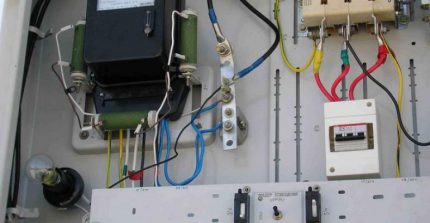
Voltage is called the potential difference, in other words, the work invested in moving the charge from one point to another. It is expressed in Volts. Potential - this is the energy at each of the points in which the charge is / was located.
By current strength is meant the number of amperes passing through the conductor in a specific unit of time. The essence of power is to reflect the speed at which the charge moved.
Power is indicated in watts and kilowatts. It is clear that the second option is used when a too impressive four- or five-digit figure needs to be reduced for ease of perception. For this, its value is simply divided by a thousand, and the remainder is rounded up as usual in a larger direction.
To power powerful equipment you need a higher energy flow rate. The maximum allowable voltage for it is greater than for low-power equipment. For machines selected for it, the limit of operation should be higher. Therefore, accurate selection of the load with a well-executed translation of units is simply necessary.
Translation Rules
Often studying the instructions that come with some devices, you can see the power designation in volt-amperes. Experts know the difference between watts (W) and volt-amperes (VA), but practically these values mean the same thing, so nothing needs to be converted here. But kW / h and kilowatts are different concepts and they should not be confused in any case.
To demonstrate how to express electrical power through current, you need to use the following tools:
- tester;
- clamp meter;
- electrical reference book;
- a calculator.
When recalculating amperes in kW, the following algorithm is used:
- They take a voltage tester and measure the voltage in the electrical circuit.
- Using current measuring keys, measure the current strength.
- Recalculate using the formula for a constant voltage in the network or alternating.
As a result, power is received in watts. To convert them to kilowatts, divide the resulting by 1000.
We also have material on the website about the rules for transferring Amps to Watts. To read it, please go to following link.
Single phase circuit
On a single-phase circuit (220 V), most household appliances are designed. The load here is measured in kilowatts, and the AB marking contains amperes.
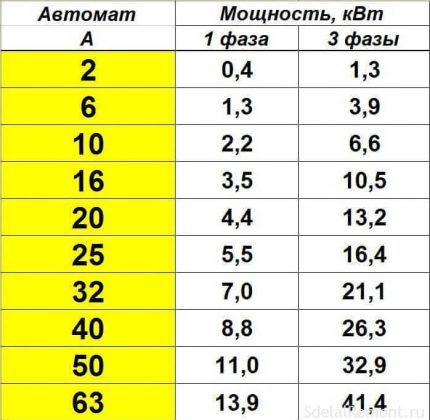
The key to the translation in this case is Ohm’s law, which states that P, i.e. power equal I (current) times U (voltage). We spoke in more detail about the calculation of power, current and voltage, as well as the relationship of these values in this article.
This implies:
kW = (1A x 1 V) / 1 0ᶾ
But what does it look like in practice? To understand, consider a specific example.
Suppose an automatic fuse on an old type meter is designed for 16 A. In order to determine the power of devices that can be safely connected to the network at the same time, you need to convert the amperes to kilowatts using the above formula.
We get:
220 x 16 x 1 = 3520 W = 3.5 kW
For both direct and alternating current, one translation formula is applied, but it is valid only for active consumers, such as incandescent lamp heaters. Under a capacitive load, a phase shift between current and voltage necessarily occurs.
This is the power factor or cos φ. Whereas if there is only an active load, this parameter is taken as unity, then with a reactive load it must be taken into account.
If the load is mixed, the parameter value ranges from 0.85. The less the reactive component of power, the smaller the loss and the higher the power factor. For this reason, they seek to increase the latter parameter. Usually manufacturers indicate the power factor value on the label.
Three phase electric circuit
In the case of alternating current in a three-phase network, the electric current of one phase is taken, then multiplied by the voltage of the same phase. What they received is multiplied by the cosine phi.
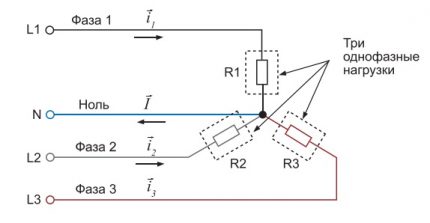
After counting the voltage in all phases, the obtained data is added up. The amount obtained as a result of these actions is the power of the electrical installation connected to a three-phase network.
The basic formulas are as follows:
Watt = √3 Ampere x Volt or P = √3 x U x I
Ampere = √3 x Volt or I = P / √3 x U
It should be understood about the difference between the phase and linear voltage, as well as between the linear and phase currents. In any case, the conversion of amperes to kilowatts is performed according to the same formula. An exception is the delta connection when calculating loads connected individually.
On the cases or packaging of the latest models of electrical appliances, both the current strength and power are indicated. Possessing these data, we can consider the question of how quickly to convert amperes to kilowatts solved.
Experts apply a confidential rule for circuits with alternating current: the current strength is divided into two, if you need to roughly calculate the power in the process of selecting ballast equipment. They also do when calculating the diameter of conductors for such circuits.
Examples of converting amperes to kilowatts
Converting amperes to kilowatts is a fairly simple mathematical operation.
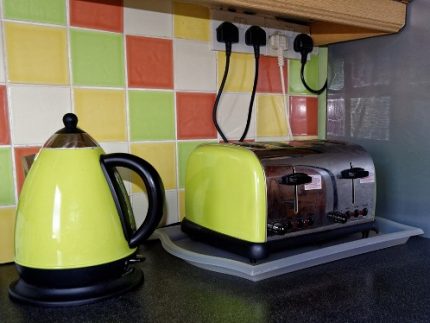
There are also many online programs where you just need to enter the known parameters and click the corresponding button.
Example No. 1 - conversion of A into kW in a single-phase 220V network
We are faced with the task: to determine the maximum power acceptable for a single-pole circuit breaker with a rated current of 25 A.
We apply the formula:
P = U x I
Substituting the values that are known, we get: P = 220 V x 25 A = 5 500 W = 5.5 kW.
This means that consumers can be connected to this machine, whose total power does not go beyond 5.5 kW.
According to the same scheme, it is possible to solve the problem of selecting the wire cross section for an electric kettle consuming 2 kW.
In this case I = P: U = 2000: 220 = 9 A.
This is a very small value. You need to seriously approach the choice of wire cross section and material. If you give preference to aluminum, it will withstand only light loads, copper from the same diameter will be twice as powerful.
For more information about choosing the right wire section for the home wiring device, as well as the rules for calculating the cable section for power and diameter, we examined in the following articles:
- Wire cross section for home wiring: how to correctly calculate
- Calculation of cable cross-section by power and current: how to calculate wiring correctly
- How to determine the cross-section of a wire by diameter and vice versa: ready-made tables and calculation formulas
Example No. 2 - reverse translation in a single-phase network
Let's complicate the task - we will demonstrate the process of converting kilowatts to amperes. We have a certain number of consumers.
Among them:
- four incandescent lamps each of 100 watts;
- one 3 kW heater;
- one PC with a power of 0.5 kW.
The determination of the total power is preceded by bringing the values of all consumers to one indicator, more precisely - kilowatts should be converted to watts.
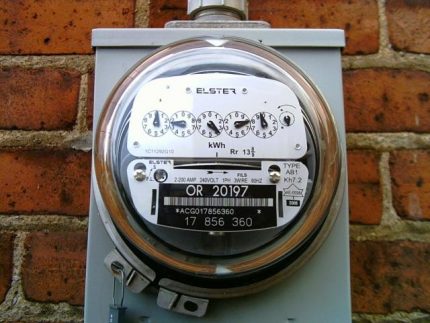
The heater power is 3 kW x 1000 = 3000 watts. Computer power - 0.5 kW x 1000 = 500 watts. Lamps - 100 W x 4 pcs. = 400 watts.
Then the generalized power: 400 W + 3000 W + 500 W = 3 900 W or 3.9 kW.
This power corresponds to the current strength I = P: U = 3900W: 220V = 17.7 A.
It follows from this that an automatic machine designed for a rated current of not less than 17.7 A should be purchased.
The most appropriate load of 2.9 kW is a standard single-phase machine of 20 A.
Example No. 3 - conversion of amperes to kW in a three-phase network
The algorithm for converting amperes to kilowatts and in the opposite direction in a three-phase network differs from the network in single-phase only by the formula. Suppose we need to calculate what is the greatest power AB can withstand, whose rated current is 40 A.
Known data is substituted into the formula and obtained:
P = √3 x 380 V x 40 A = 26,296 W = 26.3 kW
Three-phase battery at 40 A is guaranteed to withstand a load of 26.3 kW.
Example No. 4 - reverse translation in a three-phase network
If the power of the consumer connected to the three-phase network is known, the current of the machine can be easily calculated. Suppose there is a three-phase consumer with a capacity of 13.2 kW.
In watts it will be: 13.2 ct x 1000 = 13,200 W
Next, the current strength: I = 13,200W: (√3 x 380) = 20.0 A
It turns out that this consumer needs a 20 A machine.
For single-phase devices, the following rule exists: one kilowatt corresponds to 4.54 A. One ampere is 0.22 kW or 220 V. This statement is a direct result arising from formulas for a voltage of 220 V.
Conclusions and useful video on the topic
About the connection of watts, amperes and volts:
The relationship between amperes and kilovolts describes Ohm's law. Here, the inverse proportionality of the electric current with respect to the resistance is observed. As for the voltage, there is a direct dependence of the current strength on this parameter.
Do you have any questions regarding the principle of transferring Amps to Kilowatts or want to clarify the nuances of practical calculation? Ask your questions to our experts in the comments section below the article.
If you have useful information that supplements the above material, or clarifications, corrections, write your comments and additions below.

 Converting Amperes to Watts: rules and practical examples of the conversion of voltage and current units
Converting Amperes to Watts: rules and practical examples of the conversion of voltage and current units  How to calculate power, current and voltage: principles and examples of calculation for domestic conditions
How to calculate power, current and voltage: principles and examples of calculation for domestic conditions  Convert kilowatts to horsepower: how many drugs in one kW + principles and calculation methods
Convert kilowatts to horsepower: how many drugs in one kW + principles and calculation methods  Uninterrupted for the computer: rating of the best UPS
Uninterrupted for the computer: rating of the best UPS 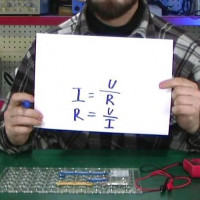 Ohm's law for the complete chain and for the section of the chain: writing formulas, description and explanation
Ohm's law for the complete chain and for the section of the chain: writing formulas, description and explanation  How much does it cost to connect gas to a private house: the price of organizing gas supply
How much does it cost to connect gas to a private house: the price of organizing gas supply  The best washing machines with dryer: model rating and customer tips
The best washing machines with dryer: model rating and customer tips  What is the color temperature of light and the nuances of choosing the temperature of the lamps to suit your needs
What is the color temperature of light and the nuances of choosing the temperature of the lamps to suit your needs  Replacement of a geyser in an apartment: replacement paperwork + basic norms and requirements
Replacement of a geyser in an apartment: replacement paperwork + basic norms and requirements
kW = (1A x 1 V) x 1 0ᶾ - must be divided by 1000, not multiplied.